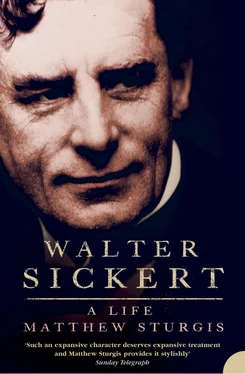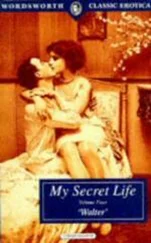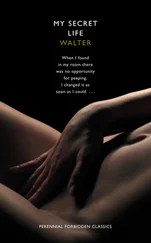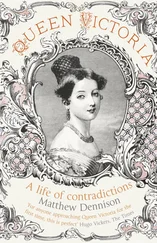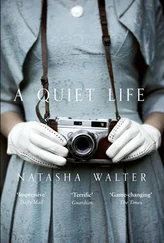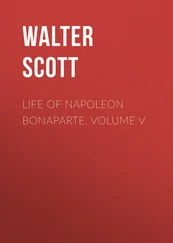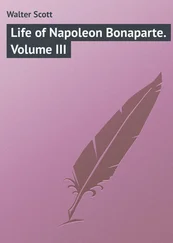The party remained in Cornwall till January 1884. It was, in Menpes’ recollection, a ‘simple happy time’. There were occasional respites from work: days spent fishing from the rocks, with Whistler springing nimbly about in his patent leather pumps. During the long winter evenings there was scope for talk and discussion. Whistler had a chance to refine his ideas on Nature (‘a poor creature after all – as I have often told you – poor company certainly – and artistically, often offensive’). 95 He also began to evolve plans for the future. Sickert’s chance encounter with Alberto Ludovici seems to have awakened a curiosity in Whistler about the Society of British Artists. He was fifty and still an outsider. Contemporaries such as Leighton and Poynter had achieved established positions at the Royal Academy. What, he began to consider, might he not accomplish with the structure and weight of an institution behind him?
Once back in London, Sickert called on Ludovici and mentioned to him Whistler’s interest in perhaps becoming a member of the SBA. This ‘surprised’ Ludovici, but also intrigued him. 96 The society was in a sad way: membership was falling; the most recent exhibition had been so poorly attended as to gain a reputation amongst young couples as a ‘most convenient and quiet spot for “spooning”’. 97 Whistler’s membership would certainly attract publicity. Sickert introduced his master to Ludovici, who – suitably impressed – began to canvas the SBA committee on his behalf. The members had plenty of opportunity for assessing Whistler’s work. It was much before the public that spring. His exhibition of ‘Notes – Harmonies – Nocturnes’ (many of them done at St Ives) opened at Dowdeswell’s in May with the usual fanfare and the usual ‘amazing’ catalogue.
The work that Sickert had produced in Cornwall over the winter, though not publicly exhibited, was also seen. He had taken a new studio at 13 Edwardes Square, just around the corner from Pembroke Gardens. As his mother reported proudly, ‘several people whose opinions are worth hearing’ had been there and pronounced his work ‘very good & promising’. 98 Théodore Duret and Jacques-Émile Blanche were both in town and were very probably amongst the visitors. And if they came, it is more than likely that they brought with them their friend, the art-loving Irish novelist George Moore.
Moore, then in his early thirties, was an extraordinary figure. Sickert had already seen the pastel portrait of him at Manet’s studio and so was familiar with the tall blond apparition: the long colourless face, bulbous eyes, and orange-tinged whiskers. There seemed something sub-aquatic about Moore. He was likened amongst other things to a codfish and a drowned fisherman. But he was an ardent lover of painting and France, as well as of literature and – so he was always bragging – women. He had lived in Paris for much of the 1870s and had even studied art there before embracing literature as his vocation. He had fraternized with the painters and poets of Montmartre and the Rive Gauche, and it was his proud boast that he had received his education over the marble-topped tables at the Nouvelle Athens – a café in the place Pigalle, where his tutors had been Manet and Degas. Along with his absinthe he had drunk in a knowledge of all the new literary and artistic movements that crackled across the Parisian cultural scene: Realism, Naturalism, Impressionism, Symbolism.
In his own literary experiments Moore had veered from a flirtation with sub-Baudelarian decadence (he wrote a volume of hot-house verse and claimed to have kept a pet python) to a bracing commitment to brutal naturalism à la Zola. In his artistic sympathies, however, he remained true to the Impressionists. Though living in London, he returned often to Paris and continued to see Degas and Duret – Degas admired him, and told Sickert that he was ‘very intelligent’. 99 When Manet died, Moore bought two paintings from his widow and continued to keep in touch with the evolving scene. 100
In 1883 Moore had published a novel, A Modern Lover , that dealt with a fictionalized version of the British art world. The anti-hero, Lewis Seymour, a sort of debased version of the hugely successful Lawrence Alma-Tadema, compromises his artistic integrity (and a succession of women) to devote himself to producing trite, but eminently saleable, classical nudes. His dégringolade is contrasted with the career of another painter – Thompson – leader of ‘the Moderns’. Thompson is an artist who depicts ‘acrobats’ and ‘bar girls’ for ‘his own heart’s praise, and for that of the little band of artists that surround him’. But, after years of struggle and neglect, he achieves success, partly through the canny speculations of his dealer, Mr Bendish. The story was clearly – in part – a transposition of Moore’s French experiences into an English setting. Thompson was a composite of Manet and Degas. The ‘Moderns’ were the Impressionists, and Mr Bendish was based upon Durand-Ruel, the dealer who had promoted them. In England there was, as yet, no comparable group: Whistler still stood alone. Nor was there a dealer, like Durand-Ruel, ready to back such a movement. These were gaps that Moore regretted, and that his book pointed up. 101
Sickert certainly took note, even if he did not immediately embrace Moore’s vision. In the spring of 1884 the influence and example of Whistler’s work remained paramount. Sickert was still engrossed in making sketchy etchings in the style of Whistler of London courts and thoroughfares. At the end of May, when he went down to Ramsgate, where Ellen was staying with her sisters, it was with the Whistleresque intention of doing ‘some seas’; 102 and on a visit to his old Munich friends the Fowlers at Broadway, in Worcestershire, he made pictures of corn stooks and rural slums. 103 It was only in August, when he joined the rest of the family in Dieppe, that he seems to have taken stock. He produced a small etching of the circus rider Leah Pinder. It was his first attempt at depicting a popular theatrical subject – such as Degas (or ‘Thompson’) might have tackled. 104
Back in London after the summer, Sickert discovered Tite Street in a state of upheaval. Whistler had taken a lease on a new purpose-built studio at the top of the Fulham Road. He was also looking for a new home. (He and Maud, though their relationship was deteriorating, eventually settled on a house in The Vale, a little rus-in-urbe cul-de-sac off the King’s Road.) In the midst of these practical arrangements the business of his election to the SBA was coming to a head. The committee was still nervous, but Sickert acted to assure Ludovici as to Whistler’s good faith and he, in turn, swayed the havering committee members. 105 On 21 November Whistler was duly elected, just in time to lend the cachet of his name and work to the society’s winter exhibition. It was not necessary to be a member in order to submit work for the show and Sickert, following in his master’s wake, sent in his small ‘portrait sketch’ of Théodore Duret, which was accepted. The debt to Whistler was apparent in both the picture’s style and its subject. 106
Whistler’s appearance in the ranks of the Society of British Artists created consternation amongst the public, and excitement amongst his followers. The circle of Whistler’s young disciples had been growing. Sydney Starr, an accomplished and rather dashing painter from Hull (and a former room-mate of Brandon Thomas’s), became a regular at the studio, as did William Stott, who had recently returned from several years’ studying and working in France. 107 A Canadian-born artist, Elizabeth Armstrong, then living in London with her mother, also gravitated to Whistler’s circle, anxious to learn more about etching. 108 For Sickert, Menpes, Harper Pennington, and the other established followers, these were new friends and allies. Their common enthusiasm for Whistler – and their common ambition to exhibit alongside him at the SBA’s gallery in Suffolk Street – obliterated, for the moment, all rivalries.
Читать дальше
